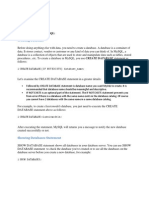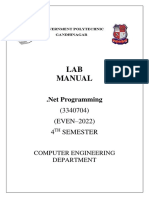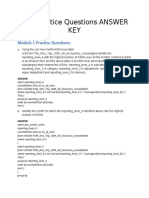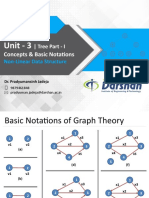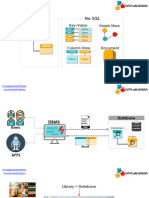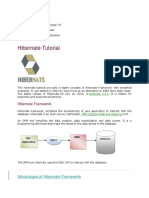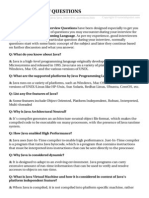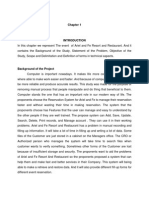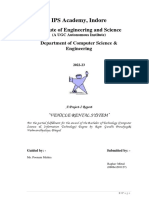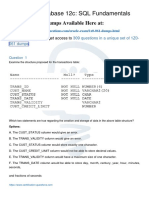Fresher Technology Specific - JAVA Stream Hibernate Framework Author: ChieuCC-F2W.
G1
FPT SOFTWARE TRAINING MATERIAL Internal use
04e-BM/NS/HDCV/FSOFT v2/3
�Course Content
Hibernate framework An Overview Hibernate association and collection mapping Hibernate object lifecycle Hibernate transaction management Hibernate querying Hibernate HQL Java Persistence API
FPT SOFTWARE TRAINING MATERIAL Internal use
04e-BM/NS/HDCV/FSOFT v2/3
�Learning Approach
The following are strongly suggested for a better learning and understanding of this course:
Noting down the key concepts in the class Analyze all the examples / code snippets provided Study and understand the self study topics Completion and submission of all the assignments, on time Completion of the self review questions in the lab guide Study and understand all the artifacts including the reference materials / e-learning / supplementary materials specified Completion of the project (if application for this course) on time inclusive of individual and group activities Taking part in the self assessment activities Participation in the doubt clearing sessions
FPT SOFTWARE TRAINING MATERIAL Internal use
04e-BM/NS/HDCV/FSOFT v2/3
�Session 1: Introduction to Hibernate
FPT SOFTWARE TRAINING MATERIAL Internal use
04e-BM/NS/HDCV/FSOFT v2/3
�Objectives
Refresher in enterprise application architectures
Traditional persistence Hibernate motivation
FPT SOFTWARE TRAINING MATERIAL Internal use
04e-BM/NS/HDCV/FSOFT v2/3
�Objectives
Refresher in enterprise application architectures
Traditional persistence Hibernate motivation
FPT SOFTWARE TRAINING MATERIAL Internal use
04e-BM/NS/HDCV/FSOFT v2/3
�N-Tier Architecture
Application is made up of layers or tiers Each layer encapsulates specific responsibilities Enables changes in one area with minimal impact to other areas of the application
FPT SOFTWARE TRAINING MATERIAL Internal use
04e-BM/NS/HDCV/FSOFT v2/3
�N-Tier Architecture (Cont)
Common tiers
Presentation
View in model-view-controller Responsible for displaying data only. No business logic
Service
Responsible for business logic
Persistence
Responsible for storing/retrieving data
FPT SOFTWARE TRAINING MATERIAL Internal use
04e-BM/NS/HDCV/FSOFT v2/3
�N-Tier Architecture (Cont)
FPT SOFTWARE TRAINING MATERIAL Internal use
04e-BM/NS/HDCV/FSOFT v2/3
�DAO Design Pattern
Data Access Object
Abstracts CRUD (Create, Retrieve, Update, Delete) operations
Benefits
Allows different storage implementations to be plugged in with minimal impact to the rest of the system Decouples persistence layer Encourages and supports code reuse
FPT SOFTWARE TRAINING MATERIAL Internal use
10
04e-BM/NS/HDCV/FSOFT v2/3
�Objectives
Refresher in enterprise application architectures
Traditional persistence Hibernate motivation
FPT SOFTWARE TRAINING MATERIAL Internal use
11
04e-BM/NS/HDCV/FSOFT v2/3
�Traditional Persistence
FPT SOFTWARE TRAINING MATERIAL Internal use
12
04e-BM/NS/HDCV/FSOFT v2/3
�JDBC Overview
JDBC API provides ability to
Establish connection to a database Execute SQL statements Create parameterized queries Iterate through results Manage database transactions
FPT SOFTWARE TRAINING MATERIAL Internal use
13
04e-BM/NS/HDCV/FSOFT v2/3
�JDBC Overview (Cont)
Basic Steps to JDBC Operations
Load driver or obtain datasource Establish connection using a JDBC URL Create statement Execute statement Optionally, process results in result set Close database resources Optionally, commit/rollback transaction
FPT SOFTWARE TRAINING MATERIAL Internal use
14
04e-BM/NS/HDCV/FSOFT v2/3
�JDBC Example Create Account
public Account createAccount(Account account) { Connection connection = null; PreparedStatement getAccountIdStatement = null; PreparedStatement createAccountStatement = null; ResultSet resultSet = null; long accountId=0; // Load driver try { Class.forName("oracle.jdbc.driver.OracleDriver"); catch (Exception e) { throw new RuntimeException(e); } try { //Get connection and set auto commit to false Connection connection = DriverManager.getConnection("jdbc:oracle: thin:lecture1/lecture1@localhost:1521:XE"); connection.setAutoCommit(false);
...
FPT SOFTWARE TRAINING MATERIAL Internal use 15
04e-BM/NS/HDCV/FSOFT v2/3
�JDBC Example Create Account(Cont)
... //Get account id from sequence getAccountIdStatement = connection .prepareStatement("SELECT ACCOUNT_ID_SEQ.NEXTVAL FROM DUAL"); resultSet = getAccountIdStatement.executeQuery(); resultSet.next(); accountId = resultSet.getLong(1); //Create the account createAccountStatement = connection .prepareStatement(AccountDAOConstants.CREATE_ACCOUNT); createAccountStatement.setLong(1, accountId); createAccountStatement.setString(2, account.getAccountType()); createAccountStatement.setDouble(3, account.getBalance()); createAccountStatement.executeUpdate(); //Commit transaction connection.commit(); } ...
FPT SOFTWARE TRAINING MATERIAL Internal use 16
04e-BM/NS/HDCV/FSOFT v2/3
�JDBC Example Create Account(Cont)
... catch (SQLException e) { //In case of exception, rollback try{ connection.rollback(); }catch(SQLException e1){// log error} throw new RuntimeException(e); } finally { //close database resources try { if (resultSet != null) resultSet.close(); if (getAccountIdStatement!= null) getAccountIdStatement.close(); if (createAccountStatement!= null) createAccountStatement.close(); if (connection != null) connection.close(); } catch (SQLException e) {// log error} } }
FPT SOFTWARE TRAINING MATERIAL Internal use 17
04e-BM/NS/HDCV/FSOFT v2/3
�Objectives
Refresher in enterprise application architectures
Traditional persistence Hibernate motivation
FPT SOFTWARE TRAINING MATERIAL Internal use
18
04e-BM/NS/HDCV/FSOFT v2/3
�Traditional Persistence vs. Hibernate
FPT SOFTWARE TRAINING MATERIAL Internal use
19
04e-BM/NS/HDCV/FSOFT v2/3
�Hibernate History
Grass roots development (2001)
Christian Bauer Gavin King
JBoss later hired lead Hibernate developers (2003)
Brought Hibernate under the Java EE specification Later officially adopted as the official EJB3.0 persistence
implementation for the JBoss application server. EJB 3.0 Expert Group (2004)
Key member which helped shape EJB3.0 and JPA
NHibernate
.NET version release in 2005
20
04e-BM/NS/HDCV/FSOFT v2/3
FPT SOFTWARE TRAINING MATERIAL Internal use
�Why Hibernate?
Impedance mismatch
Object-oriented vs. relational
Failure of EJB 2.x
Entity Beans were extremely slow, complex
Reduce application code by 30%
- Less code is better maintainable
FPT SOFTWARE TRAINING MATERIAL Internal use
21
04e-BM/NS/HDCV/FSOFT v2/3
�Why Hibernate?
Java developers are not database developers
Reduce the need for developers to know and fully understand database design, SQL, performance tuning Increase portability across database vendors
Increase performance by deferring to experts Potential decrease in database calls More efficient SQL statements Hibernate cache usage
FPT SOFTWARE TRAINING MATERIAL Internal use
22
04e-BM/NS/HDCV/FSOFT v2/3
�Summary
Refresher in application architectures Traditional Persistent implementation
JDBC example
Motivation
Origination and history of Hibernate Reasons for Hibernates development
Impedance mismatch Failure of EJB 2.x Java developers are not database developers Performance benefits
FPT SOFTWARE TRAINING MATERIAL Internal use
23
04e-BM/NS/HDCV/FSOFT v2/3
�Session 2: Walk-through of a Simple Hibernate Example
FPT SOFTWARE TRAINING MATERIAL Internal use
24
04e-BM/NS/HDCV/FSOFT v2/3
�Objectives
Creating a simple, but full, end to end Hibernate Application How to use JUnit in developing Enterprise Application
FPT SOFTWARE TRAINING MATERIAL Internal use
25
04e-BM/NS/HDCV/FSOFT v2/3
�Objectives
Creating a simple, but full, end to end Hibernate Application How to use JUnit in developing Enterprise Application
FPT SOFTWARE TRAINING MATERIAL Internal use
26
04e-BM/NS/HDCV/FSOFT v2/3
�High Level Architecture
FPT SOFTWARE TRAINING MATERIAL Internal use
04e-BM/NS/HDCV/FSOFT v2/3
�Building a Hibernate Application
1. Define the domain model 2. Setup your Hibernate configuration
hibernate.cfg.xml
3. Create the domain object mapping files
<domain_object>.hbm.xml
4. Make Hibernate aware of the mapping files
Update the hibernate.cfg.xml with list of mapping files
5. Implement a HibernateUtil class
Usually taken from the Hibernate documentation
6. Write your code
FPT SOFTWARE TRAINING MATERIAL Internal use 28
04e-BM/NS/HDCV/FSOFT v2/3
�Account Object / Table
FPT SOFTWARE TRAINING MATERIAL Internal use
29
04e-BM/NS/HDCV/FSOFT v2/3
�hibernate.cfg.xml
<?xml version="1.0" encoding="UTF-8"?> <!DOCTYPE hibernate-configuration PUBLIC "-//Hibernate/Hibernate Configuration DTD 3.0//EN" "http://hibernate.sourceforge.net/hibernate-configuration-3.0.dtd">
<hibernate-configuration> <session-factory> ... </session-factory> <hibernate-configuration>
Configure Hibernate here, particularly the session-factory
FPT SOFTWARE TRAINING MATERIAL Internal use
30
04e-BM/NS/HDCV/FSOFT v2/3
�hibernate.cfg.xml (Cont)
... <session-factory> <property name="hibernate.connection.driver_class"> oracle.jdbc.driver.OracleDriver</property> <property name="hibernate.connection.url">jdbc:oracle:thin:@localhost:1521:XE </property> <property name="hibernate.connection.username">lecture2</property> <property name="hibernate.connection.password">lecture2</property> ...
FPT SOFTWARE TRAINING MATERIAL Internal use
31
04e-BM/NS/HDCV/FSOFT v2/3
�hibernate.cfg.xml (Cont)
... <property name="dialect"> org.hibernate.dialect.Oracle10gDialect</property> <property name="connection.pool_size">1</property> <property name="current_session_context_class">thread</property> <property name="show_sql">true</property> <property name="format_sql">false</property> </session-factory>
FPT SOFTWARE TRAINING MATERIAL Internal use
32
04e-BM/NS/HDCV/FSOFT v2/3
�Configuring Hibernate
There are multiple ways to configure Hibernate, and an application can leverage multiple methods at once Hibernate will look for and use configuration properties in the following order
hibernate.properties (when new Configuration() is called) hibernate.cfg.xml (when configure() is called on Configuration) Programatic Configuration Settings
FPT SOFTWARE TRAINING MATERIAL Internal use
33
04e-BM/NS/HDCV/FSOFT v2/3
�Configuring Hibernate(Cont)
FPT SOFTWARE TRAINING MATERIAL Internal use
34
04e-BM/NS/HDCV/FSOFT v2/3
�Object Mapping Files
<?xml version="1.0"?> <!DOCTYPE hibernate-mapping PUBLIC "-//Hibernate/Hibernate Mapping DTD 3.0//EN" "http://hibernate.sourceforge.net/hibernate-mapping-3.0.dtd"> <hibernate-mapping> <class> ... Describe your class attributes here. </class> </hibernate-mapping>
FPT SOFTWARE TRAINING MATERIAL Internal use
35
04e-BM/NS/HDCV/FSOFT v2/3
�Account.hbm.xml Mapping File
... <class name="courses.hibernate.vo.Account table="ACCOUNT"> <id name="accountId" column="ACCOUNT_ID"> <generator class="native"/> </id> <property name="creationDate" column="CREATION_DATE type="timestamp" update="false"/> <property name="accountType" column="ACCOUNT_TYPE type="string" update="false"/> <property name="balance" column="BALANCE type="double"/> </class> ...
FPT SOFTWARE TRAINING MATERIAL Internal use
36
04e-BM/NS/HDCV/FSOFT v2/3
�Hibernate ID Generators
Native:
Leverages underlying database method for generating ID (sequence, identity, etc)
Increment:
Automatically reads max value of identity column and increments by 1
UUID:
Universally unique identifier combining IP & Date (128bit)
Many more
37
04e-BM/NS/HDCV/FSOFT v2/3
FPT SOFTWARE TRAINING MATERIAL Internal use
�Make Hibernate aware of the mapping files
... <property name="dialect">org.hibernate.dialect.Oracle10gDialect </property> <property name="connection.pool_size">1</property> <property name="current_session_context_class">thread</property> <property name="show_sql">true</property> <property name="format_sql">false</property> <mapping resource="Account.hbm.xml"/> </session-factory>
FPT SOFTWARE TRAINING MATERIAL Internal use
38
04e-BM/NS/HDCV/FSOFT v2/3
�HibernateUtil
Convenience class to handle building and obtaining the Hibernate SessionFactory
Use recommended by the Hibernate org
SessionFactory is thread-safe
Singleton for the entire application
Used to build Hibernate Sessions
Hibernate Sessions are NOT thread safe One per thread of execution
FPT SOFTWARE TRAINING MATERIAL Internal use
39
04e-BM/NS/HDCV/FSOFT v2/3
�HibernateUtil (Cont)
import org.hibernate.SessionFactory; import org.hibernate.cfg.Configuration; public class HibernateUtil { private static final SessionFactory sessionFactory; // initialize sessionFactory singleton static { sessionFactory = new Configuration(). configure().buildSessionFactory(); } // method used to access singleton public static SessionFactory getSessionFactory() { return sessionFactory; } }
FPT SOFTWARE TRAINING MATERIAL Internal use 40
04e-BM/NS/HDCV/FSOFT v2/3
�Session API
How to get Hibernate Session instance
Hibernate Session
session.saveOrUpdate() session.get() session.delete()
Session session =HibernateUtil.getSessionFactory().getCurrentSession();
What about just plain save?
Its there, but not typically used session.save()
FPT SOFTWARE TRAINING MATERIAL Internal use
41
04e-BM/NS/HDCV/FSOFT v2/3
�Account DAO saveOrUpdate()
public void saveOrUpdateAccount(Account account) { Session session = HibernateUtil.getSessionFactory().getCurrentSession(); session.saveOrUpdate(account); }
Remember the number of LOC needed to do this with JDBC?
FPT SOFTWARE TRAINING MATERIAL Internal use
42
04e-BM/NS/HDCV/FSOFT v2/3
�Account DAO get()
public Account getAccount(long accountId) {
Session session = HibernateUtil.getSessionFactory().getCurrentSession(); Account account = (Account)session.get(Account.class,accountId); return account;
FPT SOFTWARE TRAINING MATERIAL Internal use
43
04e-BM/NS/HDCV/FSOFT v2/3
�Account DAO delete()
public void deleteAccount(Account account) {
Session session = HibernateUtil.getSessionFactory().getCurrentSession(); session.delete(account);
FPT SOFTWARE TRAINING MATERIAL Internal use
44
04e-BM/NS/HDCV/FSOFT v2/3
�Service Layer - AccountService
import courses.hibernate.dao.AccountDAO; import courses.hibernate.vo.Account; /** * Service layer for Account */ public class AccountService { AccountDAO accountDAO = new AccountDAO(); ... }
Declare all business methods here
FPT SOFTWARE TRAINING MATERIAL Internal use
45
04e-BM/NS/HDCV/FSOFT v2/3
�AccountService business methods
/** * Create a new account or update an existing one * @param account * account to be persisted */ public void saveOrUpdateAccount(Account account) { accountDAO.saveOrUpdateAccount(account); }
FPT SOFTWARE TRAINING MATERIAL Internal use
46
04e-BM/NS/HDCV/FSOFT v2/3
�AccountService business methods
/** * Retrieve an account * @param accountId * identifier of the account to be retrieved * @return account represented by the identifier provided */ public Account getAccount(long accountId) { return accountDAO.getAccount(accountId); }
FPT SOFTWARE TRAINING MATERIAL Internal use
47
04e-BM/NS/HDCV/FSOFT v2/3
�AccountService business methods
/** * Delete account * @param account * account to be deleted */ public void deleteAccount(Account account) { accountDAO.deleteAccount(account); }
FPT SOFTWARE TRAINING MATERIAL Internal use
48
04e-BM/NS/HDCV/FSOFT v2/3
�Testing with JUnit
JUnit is an open source framework to perform testing against units of code.
A single test class contains several test methods Provides helper methods to make assertions of expected results Common to have multiple test classes for an application
FPT SOFTWARE TRAINING MATERIAL Internal use
49
04e-BM/NS/HDCV/FSOFT v2/3
�Using JUnit
Download the jar from JUnit.org Add downloaded jar to project classpath Create a class to house your test methods, naming it anything you like (typically identifying it as a test class) Implement test methods, naming them anything you like and marking each with the @Test annotation at the method level Call the code to be tested passing in known variables and based on expected behavior, use assert helper methods provided by Junit to verify correctness
Assert.assertTrue(account.getAccountId() == 0);
FPT SOFTWARE TRAINING MATERIAL Internal use
50
04e-BM/NS/HDCV/FSOFT v2/3
�JUnit and Eclipse
FPT SOFTWARE TRAINING MATERIAL Internal use
51
04e-BM/NS/HDCV/FSOFT v2/3
�JUnit and Eclipse
FPT SOFTWARE TRAINING MATERIAL Internal use
52
04e-BM/NS/HDCV/FSOFT v2/3
�Test Create
@Test public void testCreateAccount() { Session session = HibernateUtil.getSessionFactory().getCurrentSession(); session.beginTransaction(); Account account = new Account(); // no need to set id, Hibernate will do it for us account.setAccountType(Account.ACCOUNT_TYPE_SAVINGS); account.setCreationDate(new Date()); account.setBalance(1000L); // confirm that there is no accountId set Assert.assertTrue(account.getAccountId() == 0);
...
FPT SOFTWARE TRAINING MATERIAL Internal use
53
04e-BM/NS/HDCV/FSOFT v2/3
�Test Create (Cont)
... // save the account AccountService accountService = new AccountService(); accountService.saveOrUpdateAccount(account); session.getTransaction().commit(); HibernateUtil.getSessionFactory().close(); System.out.println(account); // check that ID was set after the hbm session Assert.assertTrue(account.getAccountId() > 0); }
FPT SOFTWARE TRAINING MATERIAL Internal use
54
04e-BM/NS/HDCV/FSOFT v2/3
�Handling Transactions
Why am I starting/ending my transactions in my test case?
In order to take advantage of certain Hibernate features, the Hibernate org recommends you close your transactions as late as possible. For test cases, this means in the tests themselves Later well discuss suggested ways of handling this within applications
FPT SOFTWARE TRAINING MATERIAL Internal use
55
04e-BM/NS/HDCV/FSOFT v2/3
�Test Get
@Test public void testGetAccount() { Account account = createAccount(); // create account to get Session session = HibernateUtil.getSessionFactory().getCurrentSession(); session.beginTransaction(); AccountService accountService = new AccountService(); Account anotherCopy = accountService.getAccount(account.getAccountId()); // make sure these are two separate instances Assert.assertTrue(account != anotherCopy); session.getTransaction().commit(); HibernateUtil.getSessionFactory().close(); }
56
FPT SOFTWARE TRAINING MATERIAL Internal use
04e-BM/NS/HDCV/FSOFT v2/3
�Test Update Balance
@Test public void testUpdateAccountBalance() { // create account to update Account account = createAccount(); Session session = HibernateUtil.getSessionFactory().getCurrentSession(); session.beginTransaction(); AccountService accountService = new AccountService(); account.setBalance(2000); accountService.saveOrUpdateAccount(account); session.getTransaction().commit(); HibernateUtil.getSessionFactory().close(); ...
FPT SOFTWARE TRAINING MATERIAL Internal use
57
04e-BM/NS/HDCV/FSOFT v2/3
�Test Update Balance (Cont)
... Session session2 = HibernateUtil.getSessionFactory().getCurrentSession(); session2.beginTransaction(); Account anotherCopy = accountService.getAccount(account.getAccountId()); System.out.println(anotherCopy); // make sure the one we just pulled back from the // database has the updated balance Assert.assertTrue(anotherCopy.getBalance() == 2000); session2.getTransaction().commit(); HibernateUtil.getSessionFactory().close(); }
FPT SOFTWARE TRAINING MATERIAL Internal use
58
04e-BM/NS/HDCV/FSOFT v2/3
�Test Delete
@Test public void testDeleteAccount() { // create an account to delete Account account = createAccount(); Session session = HibernateUtil.getSessionFactory().getCurrentSession(); session.beginTransaction(); AccountService accountService = new AccountService(); // delete the account accountService.deleteAccount(account); session.getTransaction().commit(); HibernateUtil.getSessionFactory().close(); ...
FPT SOFTWARE TRAINING MATERIAL Internal use
59
04e-BM/NS/HDCV/FSOFT v2/3
�Test Delete (Cont)
... Session session2 = HibernateUtil.getSessionFactory().getCurrentSession(); session2.beginTransaction(); // try to get the account again -- should be null Account anotherCopy = accountService.getAccount(account.getAccountId()); System.out.println("var anotherCopy = "+ anotherCopy); Assert.assertNull(anotherCopy); session2.getTransaction().commit(); HibernateUtil.getSessionFactory().close(); }
FPT SOFTWARE TRAINING MATERIAL Internal use
60
04e-BM/NS/HDCV/FSOFT v2/3
�Summary
End to end Hibernate Application
- Configuration hibernate.cfg.xml
<property name="hibernate.connection.url">jdbc:oracle:thin:@localhost:1521:XE </property>
- Object mapping files Account.hbm.xml
<class name="courses.hibernate.vo.Account table="ACCOUNT"> <property name="accountType column="ACCOUNT_TYPE type="string" update="false"/>
FPT SOFTWARE TRAINING MATERIAL Internal use
61
04e-BM/NS/HDCV/FSOFT v2/3
�Summary (Cont)
HibernateUtil to handle Session
static { sessionFactory = newConfiguration() .configure().buildSessionFactory(); } public static SessionFactory getSessionFactory() { return sessionFactory; }
Writing the implementation
Session session = HibernateUtil.getSessionFactory().getCurrentSession(); session.saveOrUpdate(account);
FPT SOFTWARE TRAINING MATERIAL Internal use
62
04e-BM/NS/HDCV/FSOFT v2/3
�Q&A
FPT SOFTWARE TRAINING MATERIAL Internal use
63
04e-BM/NS/HDCV/FSOFT v2/3












